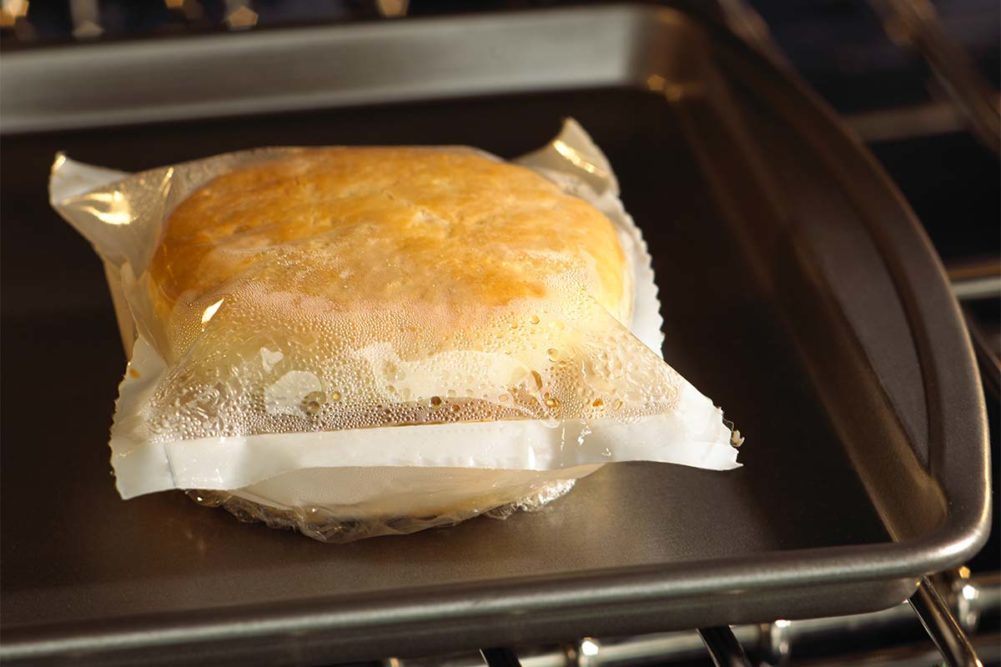Busy lives mean convenience is a necessity when it comes to food preparation. Mintel, Chicago, found 51% of consumers say easy to prepare is a crucial factor in product choice. This is why oven-ready/ovenable packaging continues to satisfy those who desire convenient, quality, fresh proteins with minimal preparation.
“The desire for convenience, food safety and fresh food quality are key drivers in today’s marketplace,” said Melanie Bandari, senior marketing manager, Amcor, Oshkosh, Wis. “Successful food manufacturers are capitalizing on the critical role packaging plays in meeting these demands, and packaging enables new growth opportunities and category expansion by delivering on convenience, safety and freshness.”
Ease and Convenience
As convenience reigns supreme, more people are reaching for protein and solutions that streamline routines and meal planning. Mintel found 57% of Millennials are interested in microwave and oven-ready convenient meal solutions, which hold more appeal than deli-prepared food. Gen X and Gen Z consumers also express interest in convenient meal options at 38%, according to the 2023 Power of Meat report.
The popularity of ovenable packaging is also supported by the growing prominence of one-to-two-person households with one-person households representing 29% and two-person households representing 35%, according to Minneapolis-based Cargill’s Protein Profile trends report. Changes in household size imply consumers will demand more single-serve dinner options in smaller packaging sizes and those consumers might begin to rely more on less energy-intensive cooking options such as the microwave and air fryer. Global flavor expansion has also greatly impacted protein-centric meals and snacks, according to Cargill.
“As the ‘standard’ family size continues to shrink and one-to-two person households gain prominence, the shift means new ways of shopping and an increased demand for smaller packages of protein to avoid food waste and better manage monthly grocery budgets,” said Hillary Gerard, marketing director, Cargill North American Protein business.
Ovens and stovetops currently remain the most-used appliance for preparing meat and poultry, but Cargill found 76% use an air fryer, up from 39% in 2019. Amcor’s ovenable CPET+ trays work well in air fryers up to 425°F. The CPET+ trays can also be paired with high-barrier, high-shrink, and high-transparency LidTite MAP shrink lidding films to elevate brand image, according to Bandari.
Build-On Technology
Modern advancements continue to build upon polymer technology developed in the 1970s with polypropylene and polyethylene (PET) being the earliest examples of heat-stable and non-reactive innovations for packaging. Advancements and expansions in the field are occurring in the form of format changes and in the types of products employing ovenable films, according to Bryan Mueller, marketing manager, Amcor. Flexible film applications for freezer and refrigerated options range from rollstock to premade pouches in both flexible and rigid structures.
Amcor’s OvenRite ovenable packaging runs on existing equipment with no or minimal machine setting changes, and processors can maximize productivity with forming and sealing at lower processing temperatures. Improved sealing delivers leak-free packaging to reduce rework and contamination.
“On the product side, the introduction of flexible ovenable solutions makes it possible for processors to offer this convenience at a relatively lower cost,” Mueller said. “While options have long been popular in the prepared meals segment, ovenable packaging has now expanded to include full meat protein cuts,” he continued.
Multivac, Kansas City, Mo., offers temperature resistant MultiCook film for meat, fish, poultry and convenience foods. Film technology offers the ability to transport, sell and cook food in the same package while maintaining the aroma, vitamins, minerals and moisture of the product.
Films work well for portioned meat, minced meat and large primary cuts and offer the ability to present products securely and attractively. Film packs cling tightly to display the contour and texture of the fresh meat product without loss of quality or weight while also offering security in a wrapper that is puncture resistant.
Tidy seals and hinges also play a significant role, keeping marinades and liquids in the package during transport and during the cooking process to imbue proteins with enhanced moisture and flavor while keeping oxygen and contaminants out. The PaperSeal Cook tray from Harpak-Ulma, Taunton, Mass., features a one-piece continuous sealing flange to prevent leaks and ensure robustness through the supply chain. In a nod to sustainability, the liner film can be separated to recycle the paperboard.
The company also offers recyclable rollstock film and crystallized polyethylene terephthalate (C-PET) and polypropylene (PP) containers and trays. These materials allow for optimal shelf life, thermal conditioning like freezing and thawing for better preservation, and better durability and resistance to the rigors and damages of transport. From a food safety perspective, a perpetually sealed product equals a safer product, and one that maximizes freshness and minimizes waste, a major concern for today’s budget-conscious consumers.
Trust and the bottom line
The value of conveniently packaged protein entrees that allow for easy prep and easy clean-up, give shoppers more time for things they love, according to Harpak-Ulma’s “The Ease and Convenience of Cook-in Poultry Packaging” article. Cook-in packaging offers the ability to freeze, thaw and cook protein with no sacrifice to quality, freshness or flavor. An easy-to-cook, easy-to-open, minimal-clean-up option also allows manufacturers to provide customers with an eating experience that builds trust, brand awareness and a better bottom line.
With an estimated 93% still seeing food cost inflation as a concern, consumers will be looking for options that make the most of their time and money, according to an IDDBA/Circana January 2024 Dairy, Deli, Bakery Trends webinar. With 80% of meals made at home, proteins in ovenable packaging can become a prime choice for consumers in a range of demographics. Plus, these protein options in ovenable packaging can help make even the most elementary cook feel more accomplished in the kitchen.
“While some are choosing premium items to prepare at home, others are prioritizing value by choosing simpler meals while shopping and dining,” Gerard concluded. “This dichotomy reinforces that many are defining protein ‘value’ on their own terms, and it’s no longer a one-size-fits-all approach.”

